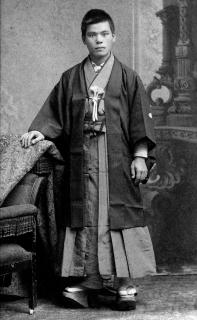Advertisement

Photo of Watari Kitashima, 1891.
As an advocate for transgender and queer justice, as a mixed race person of color of Japanese descent, the lessons of history call out to me deeply.
Growing up, I’ve had many painful moments—realizing that racism, trans antagonism, and anti-queerness would not only impact me as a person, but were baked into culture.
As a child in 1980s Ohio, what representations could I see of Asian-descent people? Where were queer and trans people? The little I did see was often tokenization, stereotypes, pity, or outright hatred. And when we were visible or recognized, it was as if we had no history.
Many Asian-descent folks get folded into a “model minority”—as if selective immigration policies and anti-Asian racism never happened and don’t persist. Many queer and trans issues are treated as if “pronouns” are entirely new, or as if queer relationships are new. Our realities and relationships have existed since time immemorial. Gender-neutral neopronouns in English have been invoked since the 1800s, and singular “they” has been used since the 1300s.
I don’t want to romanticize the past. Yet every future world we dream up builds upon the work of our ancestors. In exploring my spiritual heritage, I learned of a concept in Shinto cosmology, musubi—the power of creation and also the ties that bind, that link. This linkage connects humans and nature with the divine, but it also links us to our ancestors and our descendants, so that we can always remember: our present actions are possible because of our ancestors, and our present actions create the future for our descendants.
In the late 1990s I came out, and I quickly became more involved in social justice activism and creating spaces for queer and trans people of color. In college, I found great excitement in learning what had been completely missing from my childhood schooling—not just missing but obscured and erased. Who I am had been repressed and oppressed. So often, colonization has torn us apart from ourselves, leaving the fullness of self feeling like a fleeting memory, a distant fragment.
Over the years, it has become clearer to me. Understanding the past can be healing, can remind us that we are not alone, can give us a connection and grounding in our spiritualities and in our ancestors, can show us tools for change and problems to expect, and it can help us become more whole, to repair ourselves and to repair the world. History is power.
Knowing my histories has emboldened and spiritually rooted my activism. When I have advocated for nonbinary and gender-neutral driver’s licenses and passports, I have spoken of x-jendā (x-gender), an identity beyond the binary that has been invoked in Japan since the 1990s. I have also noted that in the Kojiki, the oldest book of Japan, the creator kami, the divine forces that created the universe, were genderless.
Some approaches to understanding history require more time, resources, and privilege than others, but everyone who has a calling can embark on a journey. History work can simply be conversations—asking your friends, family, congregants, and neighbors to tell their stories. It could be genealogy and family history. It could involve pilgrimage and learning or preserving languages. It could be starting a congregational archive.
The first Japanese person to live in the United States, Nakahama Manjirō, … attended a Unitarian church.
History work could also be reading what has already been researched. That’s how I learned so much about Japanese history in Unitarian Universalism. I knew I wanted to ground my UU experiences in understanding their intersections with my cultural heritage. So, I found some resources, including two books exploring Japanese Unitarianism: Cosmic Sage by George M. Williams and Buddhism, Unitarianism, and the Meiji Competition for Universality by Michel Mohr.
The first Japanese person to live in the United States, Nakahama Manjirō (also known as John Mung in the United States), attended a Unitarian church. He arrived in the United States in May 1843, which is one reason why Asian Pacific American Heritage Month takes place in May. There was an ordained Japanese Unitarian minister—Watari Kitashima—serving a predominantly white congregation in the United States in the 1890s.
Both the Unitarians and Universalists had missions in Japan beginning in the late 1800s. Unity Hall, the Japanese Unitarian headquarters in Tokyo from 1894 to 1922, was a vibrant space that fostered Japanese movements for socialist politics and labor union organizing. But these movements seemed insufficiently religious through the lens of the American Unitarian Association.
When the Japanese decided they had had enough of U.S. influences in their Unitarian projects, the AUA pulled out not only their staff, but surprised the
Japanese by selling off Unity Hall, largely ending the Japanese Unitarian movement. A legacy remains, however, as the former site of Unity Hall has become the headquarters of a national labor union.
History sometimes generates pride and happiness, but it also tells us about problems we must avoid and concerns we must still repair. Some Western ideas tell us that repair is about concealment, making something appear to be new again. But what about another framework? Consider kintsugi, the Japanese art of golden repair. The cracks in a broken object are filled with gold, renewing the ability to use the object, while giving beauty and recognizability to its journey. Its history is not hidden; its history is understood.